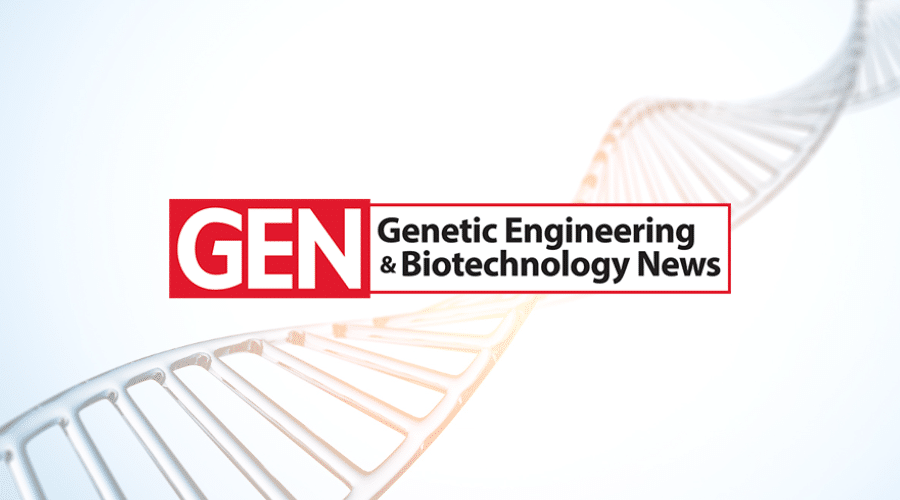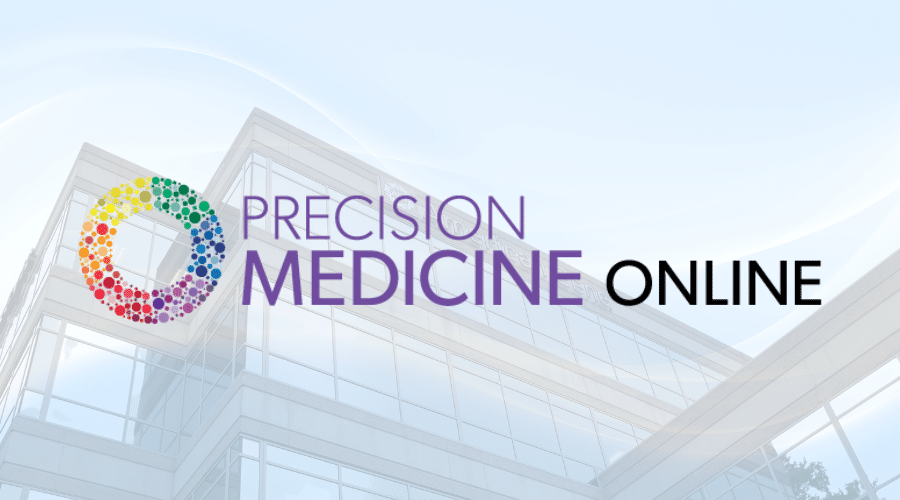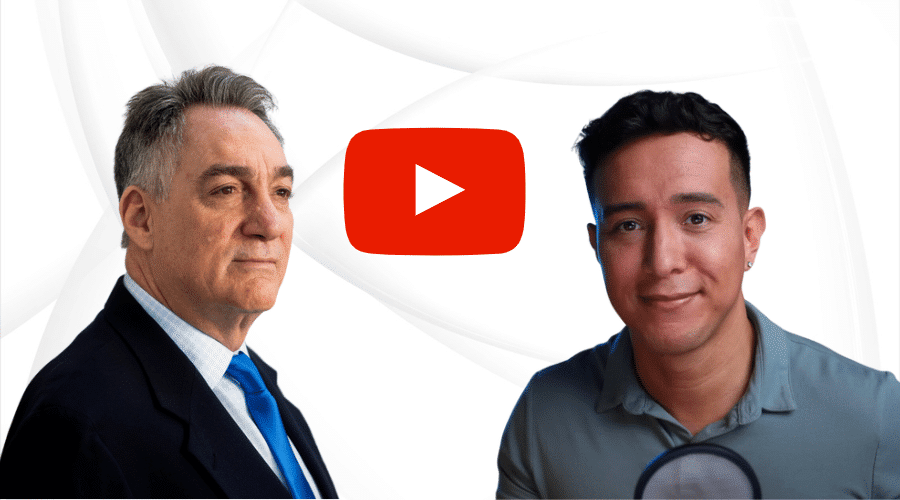Bethesda Magazine: On the Cusp of a Cure?
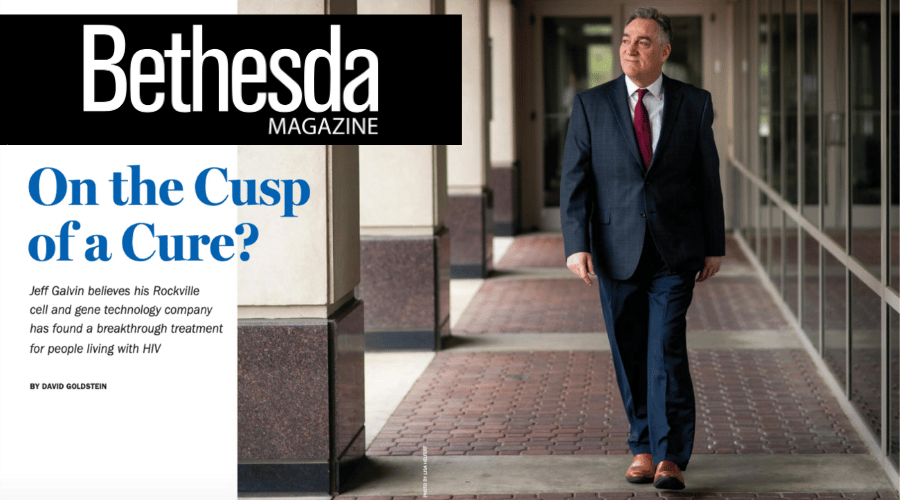
Published on: Bethesda Magazine | BY DAVID GOLDSTEIN
Jeff Galvin believes his Rockville cell and gene technology company has found a breakthrough treatment for people living with HIV
When Jeff Galvin was 13 years old, he came across a lone computer in the basement of Muzzey Junior High School in Lexington, Massachusetts. It was actually a teletype machine attached to a minicomputer. This was, after all, the 1970s.
He doesn’t remember why it was there, but he got permission to use it and taught himself how to program. “My first love affair,” Galvin recalls. “My head exploded with the possibility that you had this thing that never got tired. You just fed it electricity.”
At 15, he was taking classes at Massachusetts Institute of Technology (MIT) in nearby Cambridge and teaching computer science to high school and college students on weekends. This may be starting to sound like Good Will Hunting, the 1997 film in which actor Matt Damon plays an MIT janitor who secretly solves complex equations on a classroom blackboard, but there’s a difference. “He was a math genius,” Galvin says. “I was a highly passionate, excited kid who had just seen the most amazing toy in history.”
In his 20s, Galvin was an early recruit to Silicon Valley in those heady nascent days of the 1980s when it was fast becoming the high-tech Xanadu. His time in California included six years at Apple, but it was a visit to the National Institutes of Health in 2007 that took his career in a much different direction.

Galvin’s office at American Gene Technologies in Rockville is in the life sciences corridor, part of an area he calls “DNA Valley.” Photo by Lisa Helfert
Now 61, he’s the founder and CEO of a Rockville cell and gene technology company, and he believes his company stands on the cusp of a medical breakthrough. Galvin’s team of molecular biologists at American Gene Technologies (AGT) thinks it has developed a gene therapy procedure that can cure HIV, the virus that leads to AIDS. According to the U.S. Department of Health and Human Services, 1.1 million people are currently living with HIV in this country; the World Health Organization estimates that 75 million people across the globe have been infected with the virus since the AIDS epidemic began in 1981. About 32 million have died.
Galvin says he made HIV his target because a cure for the virus has remained elusive. People with HIV must take a daily regimen of medications that control infections and suppress the virus, but don’t eliminate it. Over time, these drugs can cause everything from nausea and fatigue to more serious conditions affecting the kidneys, heart and central nervous system, according to NIH.
He believes the gene therapy procedure AGT has developed, in which genes are transferred to modify cells or tissue through the use of viral vectors, could actually be a platform to cure any number of diseases.
“What can’t we cure with this?” Galvin says during a call to the head of a financial securities firm one afternoon in February. He’s seated at a large oval table in the AGT conference room with the phone on speaker.
Galvin spends much of his time wooing potential investors. What he brings to the task is his salesman’s personality: a bit over the top, a healthy dollop of bravado, and an inclination to push the envelope. And his company’s HIV treatment is getting a serious look—the U.S. Food and Drug Administration is determining whether the procedure is safe enough for human testing.
Galvin says the gene and cell therapy industry has been “exploding” in recent years, causing a slowdown in the regulatory process for those kinds of treatments. But AGT is hopeful that the FDA will approve the human clinical trials by this fall. “I can’t imagine we can’t cure almost everything in the world,” he says on the call. “We’re going to send chemotherapy and radiation the way of bloodletting and leeches.”
Galvin is a ball of energy and nonstop talker. Politics. Facebook’s troubled relationship with privacy. He’ll opine as long as someone will listen and he doesn’t have a pressing appointment. He is 6 feet tall, has a genial smile and an eagerness to engage. And he burns with the passion of the committed.
“We’re down here in Rockville, Maryland. Lots of good opportunities down here,” he says during the pitch, which goes on for more than an hour. “Right now [we have] the beginnings of what is turning into a revolution in pharmaceuticals…we’re talking about the creation of probably another $3 to $5 trillion industry over the next 10 to 15 years. I think this is bigger than the dot-com boom. I think it doesn’t have quite the same bubble. This isn’t the kind of thing that will all go off the cliff simultaneously like dot-com because there’s real science behind it. And if it works out, it can be monetized.”
Galvin is a cheerleader for Montgomery County’s growth as a hub for health technology. AGT is just off Interstate 270 at Exit 6B in the life sciences corridor, where it percolates among a cluster of tech, biotech and pharmaceutical companies, as well as educational centers. Branches of the University of Maryland and Montgomery College help incubate new startups. That’s the atmosphere that got AGT off the ground in 2008.
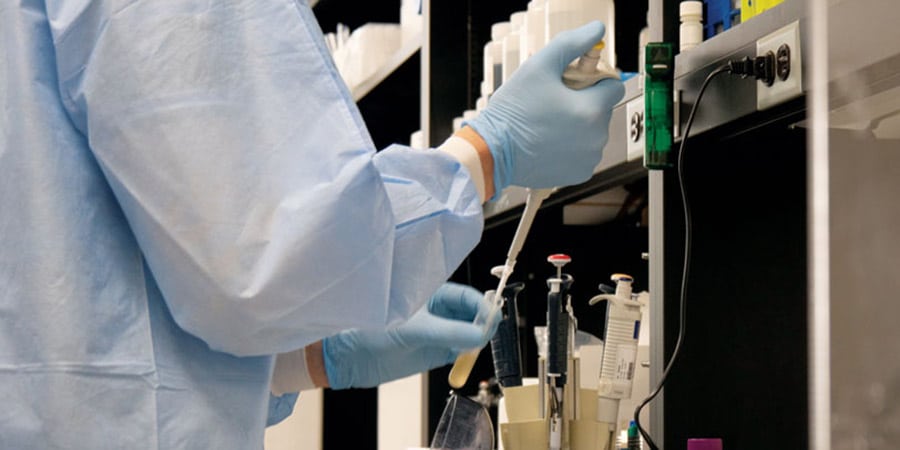
In the labs at AGT, which are spread out over 11,500 square feet, microbiologists and other scientists work with T cells, viral vectors and other microscopic particles. Photo courtesy of American Gene Technologies
In addition to HIV, AGT is developing therapies for several types of cancerous tumors that affect the breasts, lungs and prostate. The company hopes that its work on a treatment for liver cancer will be approved for human clinical trials in 2022. The lab is also working on a gene therapy for phenylketonuria, known as PKU, a rare inherited metabolic disorder.
“There’s this great economic engine which is evolving that will make Maryland the next Silicon Valley,” Galvin tells the head of the financial securities firm. “I call it DNA Valley.”
Galvin, it should be noted, is not a scientist. He’s an economist by training, a 1981 graduate of Harvard University. He’s a computer prodigy by pedigree—his mother was one of the rare female computer software experts in the 1960s, and his father is an MIT-trained electrical engineer who did national security work.
Galvin has this thing about “disruptive technologies,” he says, systems that upend the old way of doing something and change the culture in a significant way. Like how Apple co-founder Steve Jobs simplified and popularized the computer mouse. Or how GPS changed the way we get from here to there. That’s how he sees AGT and gene therapy. “I’ve been through a lot of technologies: computers, software, the internet, apps, IT,” Galvin says.
“So I understand how these technologies grow. Gene and cell therapies are bigger than any of those, and it’s much more emotional because it’s your health.”
He has a fluency in arcane subjects that aren’t connected to his own skills. This is Galvin’s explanation for how HIV infects a cell through a protein known as CCR5, located on the surface of white blood cells, and why AGT believes it has developed a defense: “One element of our cell product is the removal of CCR5 from the surface of CD4+ T cells. However…we have also added siRNAs against conserved regions of the vif and tat HIV genes for additional protection against R5 viruses as well as extending protection to CXCR4 versions of HIV.”
Here’s how he puts it in plain English: “We have removed the…‘door handle’ (CCR5) that HIV uses to get into cells. Most forms of HIV use that common surface protein in cells to infect the cell, but some forms do not need that handle. AGT has added specially designed genes to our HIV treatment that are capable of producing substances inside the cell that protect against several known ‘mutations’ of HIV that do not require that handle. AGT is the first company to provide this type of broad protection to the various known versions of HIV.”
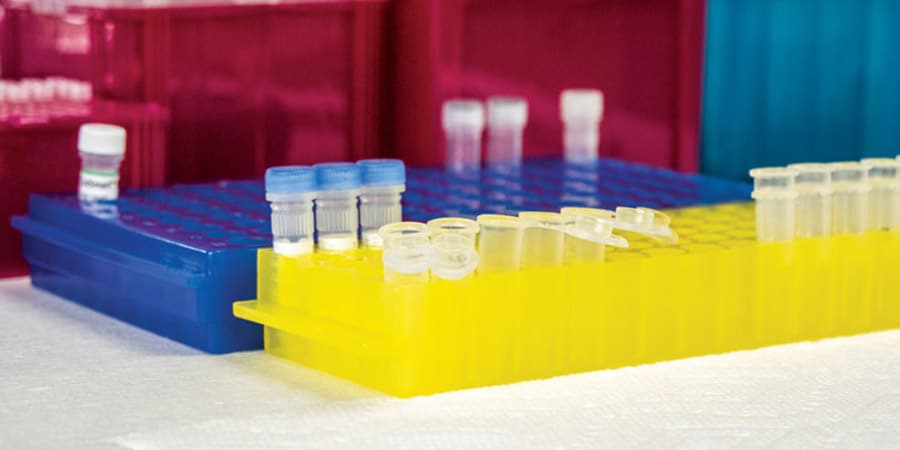
Photo courtesy of American Gene Technologies
HIV is an insidious virus that infects a patient’s T cells, a type of white blood cell that helps the body fight off infection. In Montgomery County, 3,489 people were infected with HIV between 2009 and 2018, with 123 new cases in 2018, according to the Maryland Department of Health. AGT’s gene therapy approach modifies the HIV-specific T cells so they can resist infections and do their job of protecting the body from pathogens that cause disease.
AGT does this by using viral vectors; the viruses are “cracked open” to remove the bad genes and replaced with newly modified genes that will improve the cell. “Instead of a virus with the intention of infecting you and going to the next person, it’s been tamed to do only one part of that process,” says C. David Pauza, a molecular biologist and longtime researcher in gene cloning and HIV who serves as AGT’s chief science officer. “We put things in it we want it to deliver and it makes one infection and stops—and doesn’t go any farther.” According to Galvin, once HIV T cells are able to carry out their protective work as intended, HIV patients would eventually become permanently immune to the virus and hopefully have no need to continue taking antiretroviral drugs.
AGT’s concept is not new, according to Carl Dieffenbach, director of the Division of AIDS at NIH’s National Institute of Allergy and Infectious Diseases. “What has improved are the vectors,” he says. “It’s reasonable to continue to watch this.” What’s unknown, Dieffenbach says, is the human reaction. Once the therapy is tried on people, “what you don’t know is how this will actually behave.”
Tami Howie, an attorney who represents tech and biotech companies, first met Galvin in 2017, when she was CEO of the Maryland Technology Council. “He is one of the rare people who epitomizes the convergence in tech and biotech,” she says. “He’s totally cutting edge.”
But messing around with the human genome can be fraught with risk. “We know there are viruses out there that get into your body and activate genes that do all kinds of good things and bad things,” Pauza says. “[One] good thing is a very old virus that’s in most of us that controls the efficiency of pregnancy in women. But then you can get other viruses that go in and they stimulate things to be made inappropriately and trigger horrible results.”
To Galvin, no risk, no reward. When he made public late last year that AGT was developing a cure for HIV, he was criticized by some in the HIV/AIDS community for peddling false hope. But Galvin has no regrets and is sympathetic to their concerns. “It’s reasonable to experience a gut reaction to the word ‘cure’ when humanity has been struggling against HIV for decades,” he says. “I don’t fault anyone for working to protect their community. We are always clear that we will only know for sure once we prove it in a human trial,” he says. He calls AGT’s work the “future of medicine.”
“It’s going to be typical that many of the diseases that strike you are going to be cured by gene and cell therapy,” he tells the prospective investor. “And we plan to lead that revolution because…we’re going to prove we’re the most efficient competitor in it by curing HIV this year.”
If he’s right, that would be seismic.
“Enormous,” Pauza says.
The oldest of three children, Galvin didn’t get a lot of attention when he was young so he “tended to get into a lot of trouble,” he says. “I figured out how things worked early, so it was hard to lock me in the house.”
As a child, he’d come home with a bloody hand, having found a razor blade, or wander into a snowstorm looking for twigs for the fireplace. His father, Aaron, says Galvin was “a handful” because his mind was so active. “We were on a first-name basis with all the emergency wards,” he says with a chuckle.
Galvin showed his entrepreneurial spirit early on, his father says. When he was 6 and the family’s house in Lexington was under construction, the boy collected dirt from the excavation site and sifted it through a window screen and into plastic bags. Then he pulled his little red wagon up and down the street, selling topsoil for 50 cents a bag.
Harvard didn’t offer a degree in computer science when he went there, so Galvin majored in economics and took all the computer classes he could. After graduation, he left for California to take a job with Hewlett-Packard, but he didn’t like the corporate culture and went to work for Apple. “Apple was more like me,” Galvin says. “It was in love with what computers could do.”
He stayed on the West Coast for parts of the next three decades. “Silicon Valley was on fire when I was there,” says Galvin, whose sister, Laurie, and brother, Mark, also pursued careers in the tech world. He describes the atmosphere there as a group of people with the “right ideas and…pushing things at light speed. There was such a clarity of vision and purpose. …There was no limit on what we could do there.”
It was a fast life, though. As a marketing manager and later director of international marketing for Claris, an Apple spinoff, Galvin was always on the move: Europe, the Middle East, Indonesia, New Zealand. While in Paris on a trip to show clients how to service Apple hardware, he fell asleep at the wheel while driving through a tunnel at 70 mph after having been up for three days. When he brushed a curb, he awoke and was able to right the car. But it was a chilling experience.
“How lucky can you get?” Galvin says.
In 2001, after nearly two decades of 16-hour workdays, he decided he was done. At 42, he’d made investments in startups, real estate, software and internet companies. “I looked at my bank account and realized I didn’t have to work anymore,” Galvin says.
He bought a house on Maui and traveled between there and his home in San Carlos in Silicon Valley. He started dating, thinking he should settle down before he got too old. He and his wife, Cherry, married in 2004.
The couple enjoyed a carefree life in the tropics. But after five years, Galvin was “bored out of my mind,” so they moved back to California. He decided to tiptoe back into the game by looking for a project where he could become an angel investor, someone who puts money behind a startup often in exchange for ownership equity. The word got out, and Galvin received a proposal from a postdoctoral researcher at a lab at NIH headed by Dr. Roscoe Brady, a renowned biochemist and pioneer in the treatment of enzyme deficiencies. Galvin visited the lab in 2007 and met Brady, who explained the science behind viral vectors. It was Galvin’s “eureka moment.”
“When I learned that there was a mechanism to update the DNA in a human cell, my head practically exploded,” Galvin says. He reasoned that if you look at a cell as the human body’s computer, and the DNA contained in the cell as the operating system, you could employ viral vectors to convert viruses into “updates” for the human computer and thereby correct defects.
“DNA is the instruction set for the cell,” Galvin says. “Your genes are just instructions to make enzymes and proteins that then react in the cell. Basically, your cell is an organic computer. You change the software, you change the cell.”
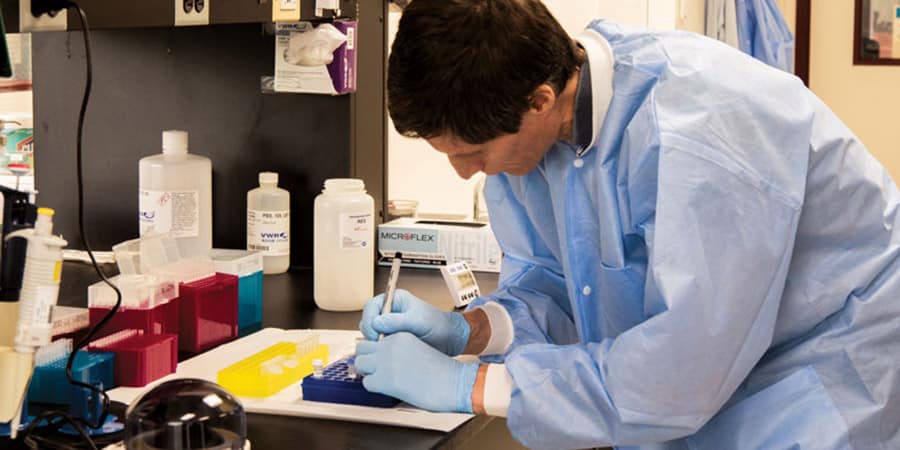
Photo courtesy of American Gene Technologies
Brady was retiring and NIH was closing his lab. Galvin says NIH gave him the intellectual property, free of charge, on the condition that he continue the research. “I felt like he was close to making major breakthroughs,” Galvin says. So he hired two of Brady’s research assistants and signed Brady on as a scientific adviser. That’s how AGT was born.
In the early days, Galvin continued to live on the West Coast and funded the work out of his own pocket. His mother, Frayda, was suffering from Stage 4 pancreatic cancer. She died in 2009 after battling the disease for 15 months. Knowing what she went through bolstered Galvin’s conviction that AGT’s work could help people. In 2010, he realized he needed to be in Rockville full time. Over the next few years, he received $1 million in grants from NIH, which was interested in innovative approaches to gene and cell therapies. Galvin says obtaining funding that way was easier than trying to lure investors, and he kicked in an additional $2 million.
AGT began as a small but determined undertaking. An early supporter was Dr. Robert Redfield, a virologist who now heads the Centers for Disease Control and Prevention and became visible during the White House coronavirus briefings in the spring. He served as an adviser to AGT beginning in 2011 and subsequently chaired the company’s clinical advisory board for its HIV gene therapy program until 2018. By that time, AGT had been granted patents for its HIV therapy and had enlisted NIH as a research partner in its search for a cure. “Fast forward to today,” Galvin says, “we have curative therapies for HIV.”
Galvin’s day usually begins “in my sweats,” he says, in the kitchen of his Rockville condo where he has a three-screen computer. He calls it “command central.” He can work uninterrupted for about three hours, and he’s usually at AGT by noon. He presides over a three-story warren of offices where employees handle regulatory affairs, marketing, finance and other administrative business.
It’s in the labs, spread over 11,500 square feet on the third floor, where the microbiologists and other scientists do the research and delicate work of separating genes, the link between one generation and the next. Behind glass walls and clad in blue protective gowns and gloves, they employ an array of biological tools as they work with T cells, viral vectors and other microscopic particles. Their findings spill out of white data machines spaced at regular intervals along the work counters.
Talking up AGT requires Galvin to travel a lot. Before the coronavirus pandemic, he was often on trains to Manhattan for meetings and dinners with prospective investors, and flying around the country for conferences and other events. But the world has new rules these days. Video conference calls and Zoom meetings have become the new way of doing business.
To relax, Galvin plays Xbox or watches The Simpsons. He enjoys how the show’s writers parody American culture.
“I can tell these people feel the same way about the world as I do,” he says. He also reads or catches up on the news. On his nightstand in February was Sapiens: A Brief History of Humankind, a New York Times bestseller.
His wife, Cherry, prefers warm weather, so she spends her winters at the couple’s home in Silicon Valley. They got married “late in life,” Galvin says, and don’t have children. Cherry’s sister, a single mother, lived with the couple and in 2004 sent for her daughter, who was 6 years old and staying with her grandmother in Wuhan, China. Now 21, Galvin’s niece, Jesse, recently graduated from the University of Washington, where she majored in molecular and cellular biology. Interning at AGT during her high school summers might have had something to do with that. “I love my niece like a daughter,” Galvin says.
Galvin says he’s having the most fun he’s ever had. Still, securing funding for new therapies and medicines can be a struggle if you’re not a pharmaceutical giant. Investors generally want a quick return, and human trials for a new drug or therapy can be costly.
“To be a successful entrepreneur and forging new territory, you get a lot of arrows in the back. A lot of people say ‘no way,’ ” says Drew Palin, a physician and chief innovation officer of Intellivisit, a Madison, Wisconsin, online medical diagnosis company. He’s also one of Galvin’s investors. “He has had to raise lots of nickels and dimes that allowed him to be a little more patient and persistent. …To do that, you have to have a lot [of] drive, a lot of personal passion and a way to survive.”
When Galvin isn’t pitching AGT’s upside to venture capitalists, blue-chip finance houses like JPMorgan Chase, big financial institutions like Citibank, and angel investors like Palin, he’s championing the promise of genetic engineering.
“I’m basically an evangelical person that is spending his entire day either connecting people with our mission and trying to engage them [in] some way to support it or propel it, or inspiring people to achieve greatness within the mission,” Galvin says.
Should AGT’s experimental HIV treatment work and eventually be approved for commercial sales, Galvin says it would likely be licensed to a large pharmaceutical company with global reach to ensure the product’s wide availability.
Galvin doesn’t have any idea how much the treatment could cost, but predicted it would be less expensive than what insurance companies now pay to cover the costs of daily antiretroviral treatments, medicine for the side effects and appointments with doctors. “He’s not chasing the dollar. He’s chasing every life he can save,” Tami Howie says. “He figures every minute he’s not working, people are dying.”
Galvin’s fundraising has pushed investments to $40 million, and his staff has grown to 30. His commitment to AGT, however, put a strain on both his marriage and retirement nest egg. “Both have survived and recovered,” he says, but it took “sustained engagement with high risk and giant potential downfall for me.”
Now he weighs the possibility that it all could pay off. “If we get a handful of cured HIV patients…I think the [National] Mall is going to look like the days of the AIDS quilt because these people have been suffering for so long,” Galvin says, “…and I think the emotional response is going to be quite profound.”
David Goldstein is a former political and investigative reporter in Washington, D.C., for McClatchy Newspapers and The Kansas City Star.
View The Original Article
This page is a replication of the original content. To respect the original publisher, this page is not indexed by search engines. The original article can be viewed by clicking the button below.

